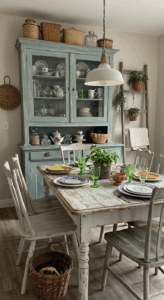1. Serene Succulents: Crafting a Desert Oasis
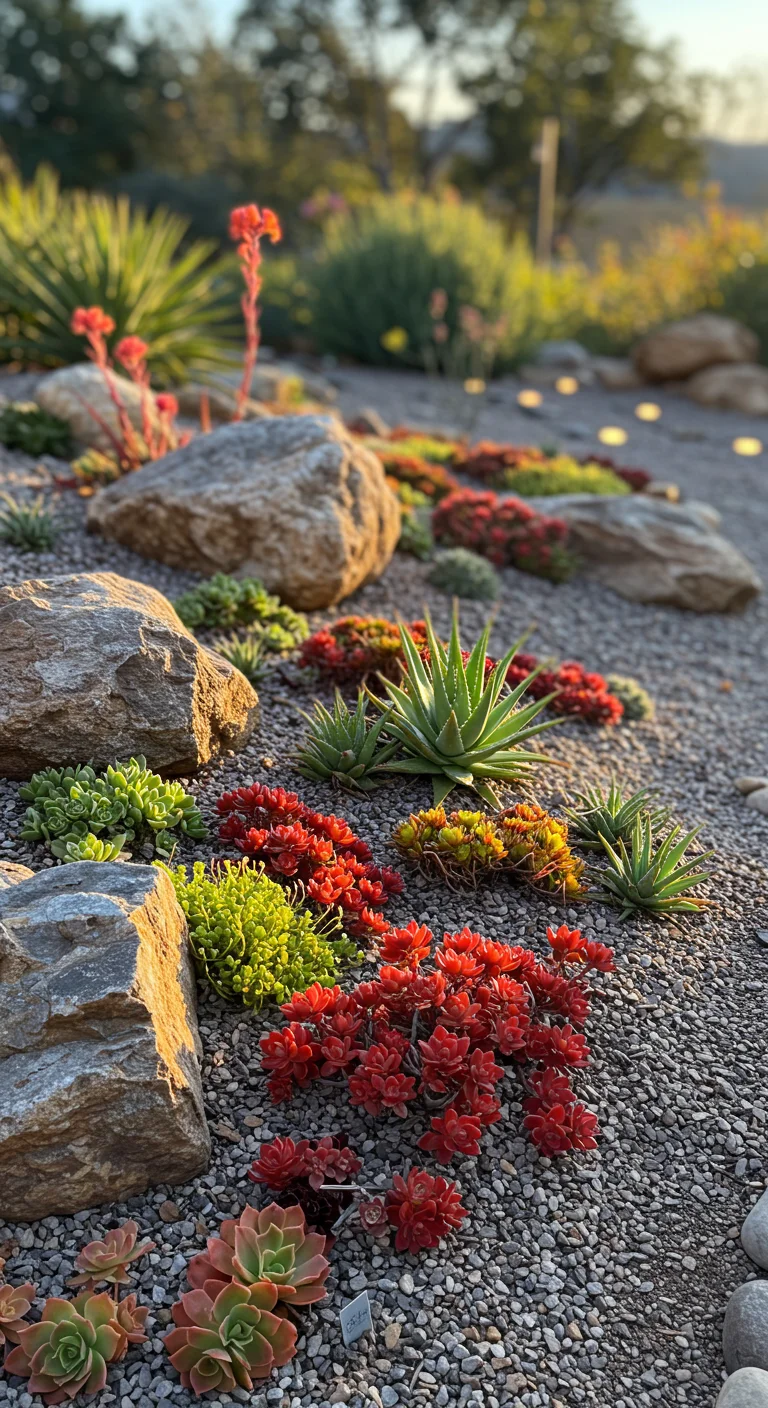
Transform your outdoor space into a tranquil desert oasis with the strategic use of succulents in your rock garden. Start by selecting a variety of drought-resistant succulents like Echeveria, Aloe, and Sedum, which not only thrive in arid conditions but also offer stunning colors and shapes. Arrange them among natural stones, using gravel or sand to create a sandy desert floor that enhances drainage and mimics a true desert landscape. Incorporate larger boulders to add depth and visual interest, while also providing shelter to small wildlife. To maintain a serene atmosphere, consider soft, ambient lighting for evening enjoyment. This approach not only creates a low-maintenance garden but also showcases the beauty of these resilient plants against the rugged backdrop of rocks, inviting relaxation and reflection in your personal sanctuary.
2. Breathtaking Boulders: The Art of Stone Placement
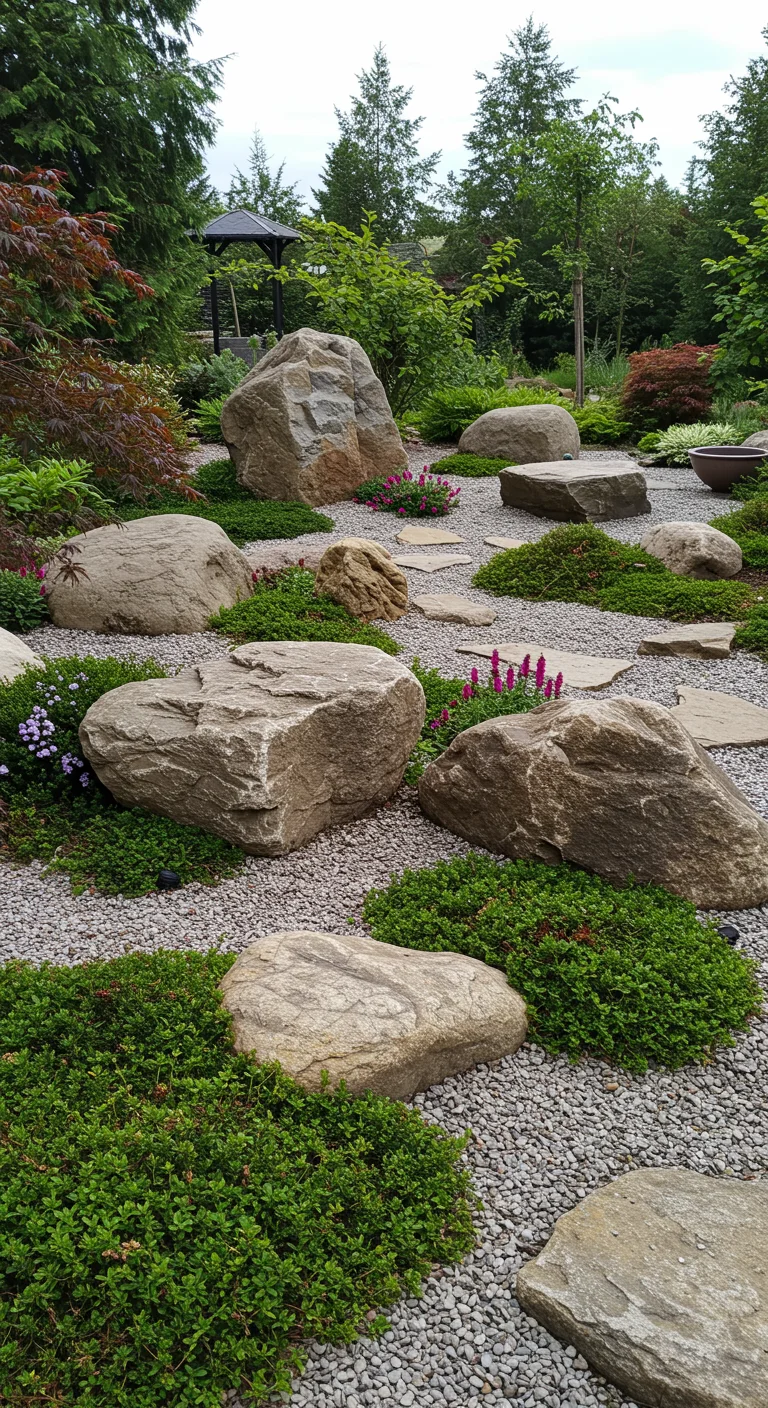
Boulders serve as the backbone of any rock garden, adding structure and visual interest. To achieve a natural look, consider the size, shape, and color of your stones, opting for a variety of textures that complement one another. Place larger boulders strategically to create focal points, while smaller stones can be used to fill in gaps and establish pathways. Aim for an uneven arrangement that mimics nature’s randomness, placing stones at varying angles to enhance depth. Additionally, surrounding boulders with hardy alpine plants or colorful groundcovers can soften their edges and create a harmonious balance. Remember, the goal is to create an inviting space that feels both serene and connected to the landscape around it.
3. Vibrant Vistas: Choosing the Right Color Palette
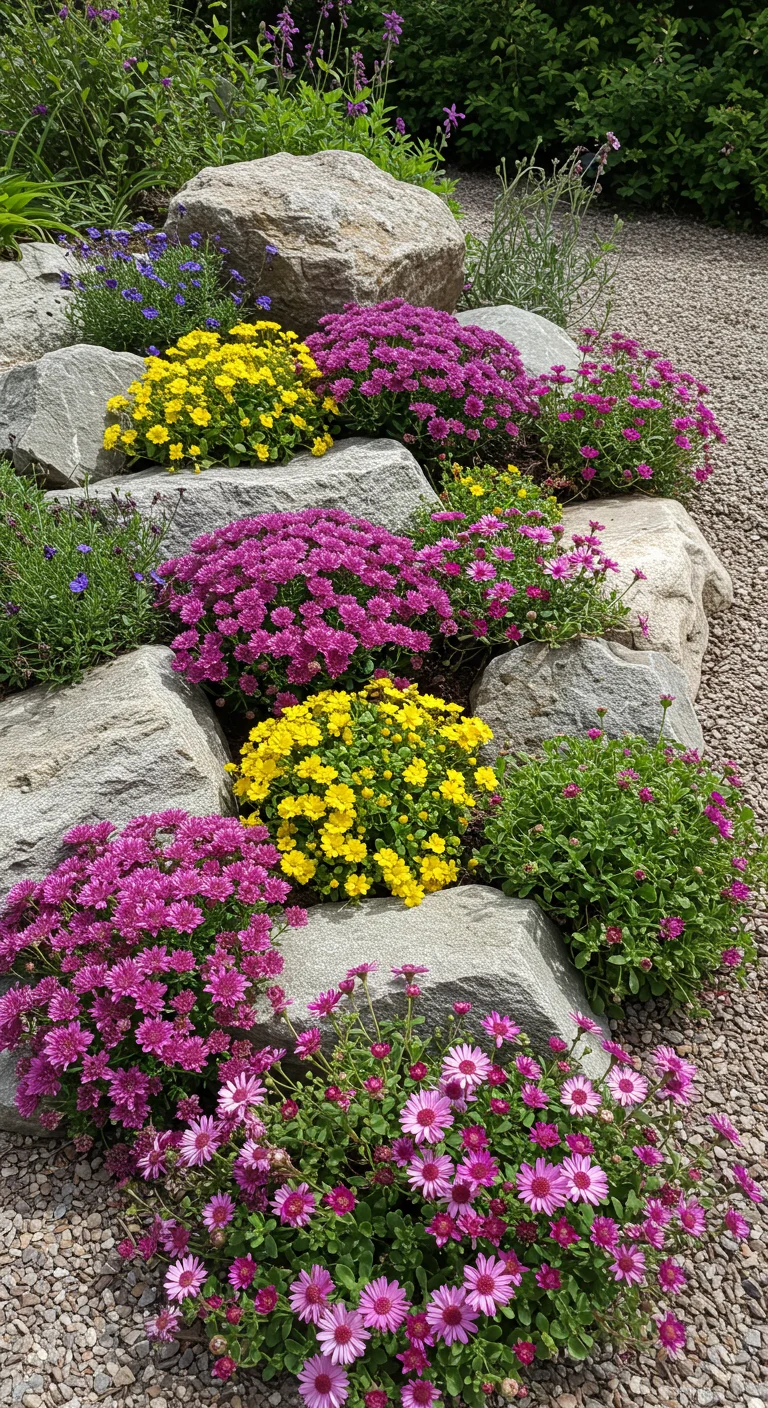
When designing a rock garden, selecting the right color palette is crucial for creating a vibrant and harmonious atmosphere. Begin by considering the natural hues of the rocks and surrounding plants; earthy tones like browns, greys, and greens serve as a wonderful backdrop for brighter flowers. Incorporate pops of color through flowering plants such as sedums, alyssum, and dwarf daisies, which bloom in purples, yellows, and pinks. For a cohesive look, choose a maximum of three to four complementary colors that enhance each other while keeping the overall aesthetic balanced. Additionally, consider seasonal variation; incorporating a mix of perennials and annuals can ensure that your rock garden remains lively throughout the year, showcasing different colors and textures with each season’s change.
4. Alpine Aesthetics: Embracing Mountain Flora
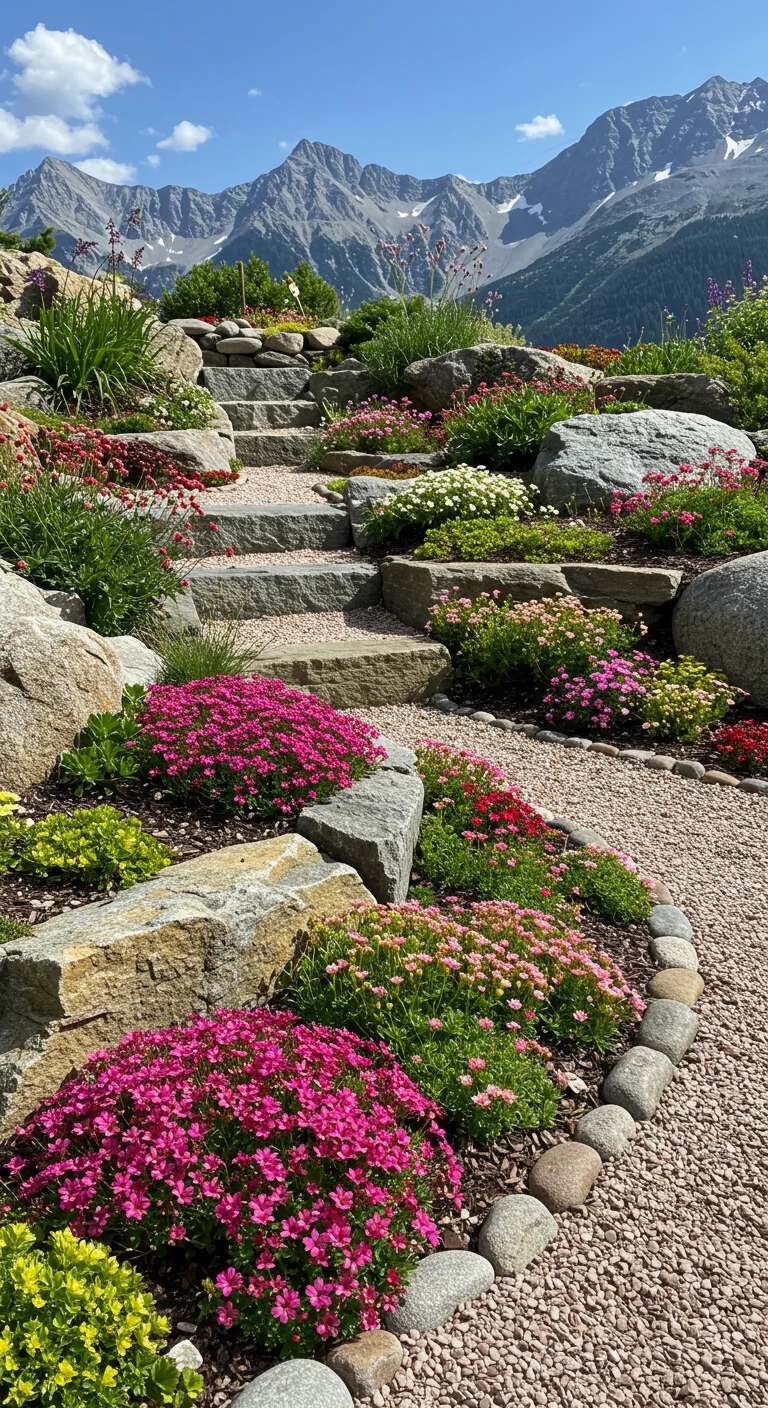
Alpine aesthetics in rock gardens draw inspiration from the stunning flora found in mountainous regions, creating a serene and picturesque environment. To embrace this theme, consider incorporating hardy alpine plants such as Saxifraga, Sempervivum, and Dianthus, which thrive in rocky, well-drained soil. These plants not only add vibrant colors and unique textures but also require minimal maintenance, making them ideal for rock gardens. Arrange them in clusters around boulders and gravel paths to mimic their natural habitat, enhancing the visual interest and depth of your space. Additionally, using natural stones and pebbles to create terraces will elevate the plants, providing the necessary drainage while showcasing their beauty. By selecting the right combination of flora and hardscaping, you can transform your rock garden into a breathtaking alpine retreat.
5. Zen Zones: Creating Tranquil Spaces with Gravel
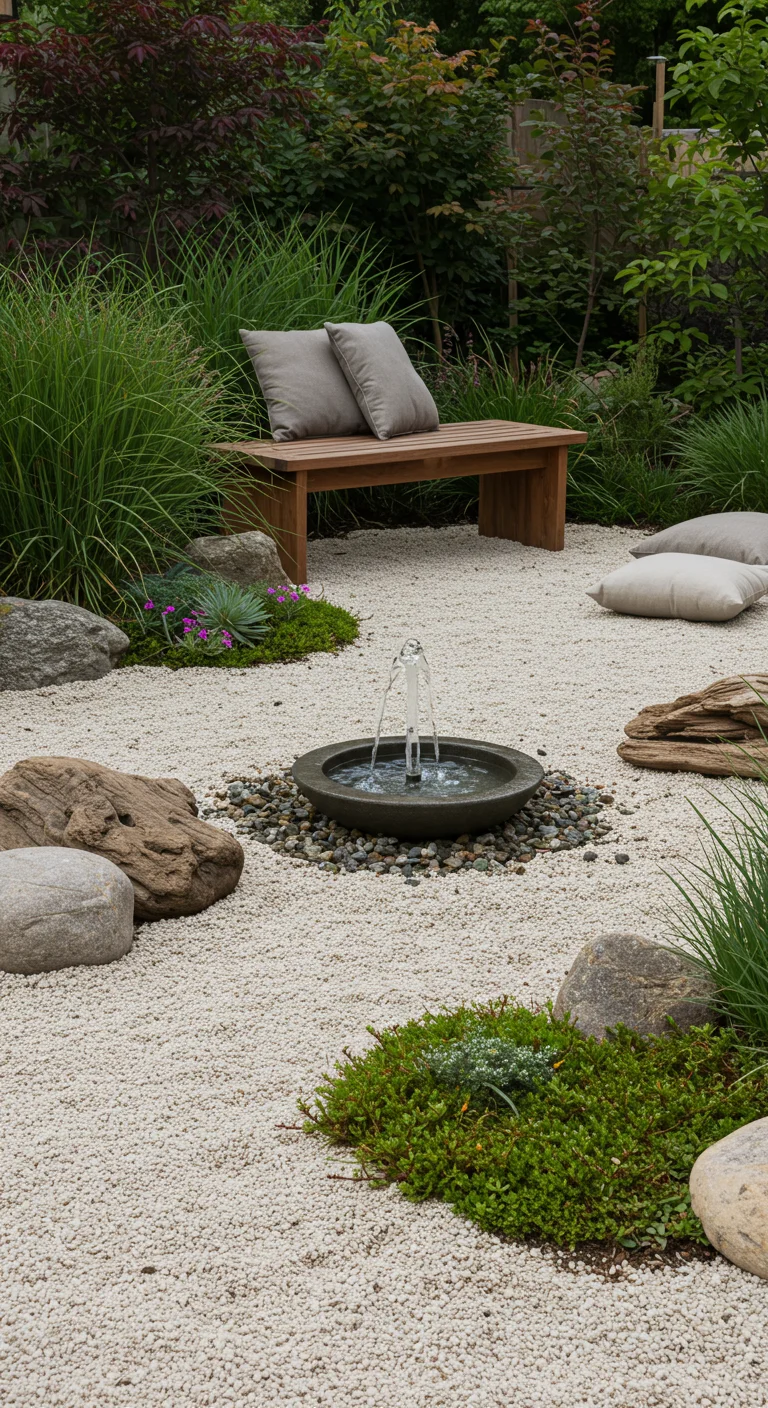
Zen Zones are all about creating serene and peaceful spaces in your outdoor area using gravel as a primary material. Start by selecting a quiet corner of your garden, where you can lay down a base of smooth, light-colored gravel to create a soft, inviting surface. Incorporate natural elements such as boulders, driftwood, or bamboo to enhance the tranquil atmosphere. Consider adding a small water feature, like a fountain or pond, to introduce the soothing sounds of flowing water. Surround your Zen Zone with low-maintenance plants, such as succulents or ornamental grasses, which thrive in gravelly conditions and provide subtle pops of color. Finally, include comfortable seating—perhaps a simple wooden bench or a cushion on the ground—inviting you to relax, meditate, or simply enjoy the beauty of your peaceful retreat.
6. Water Wonders: Integrating Ponds and Streams
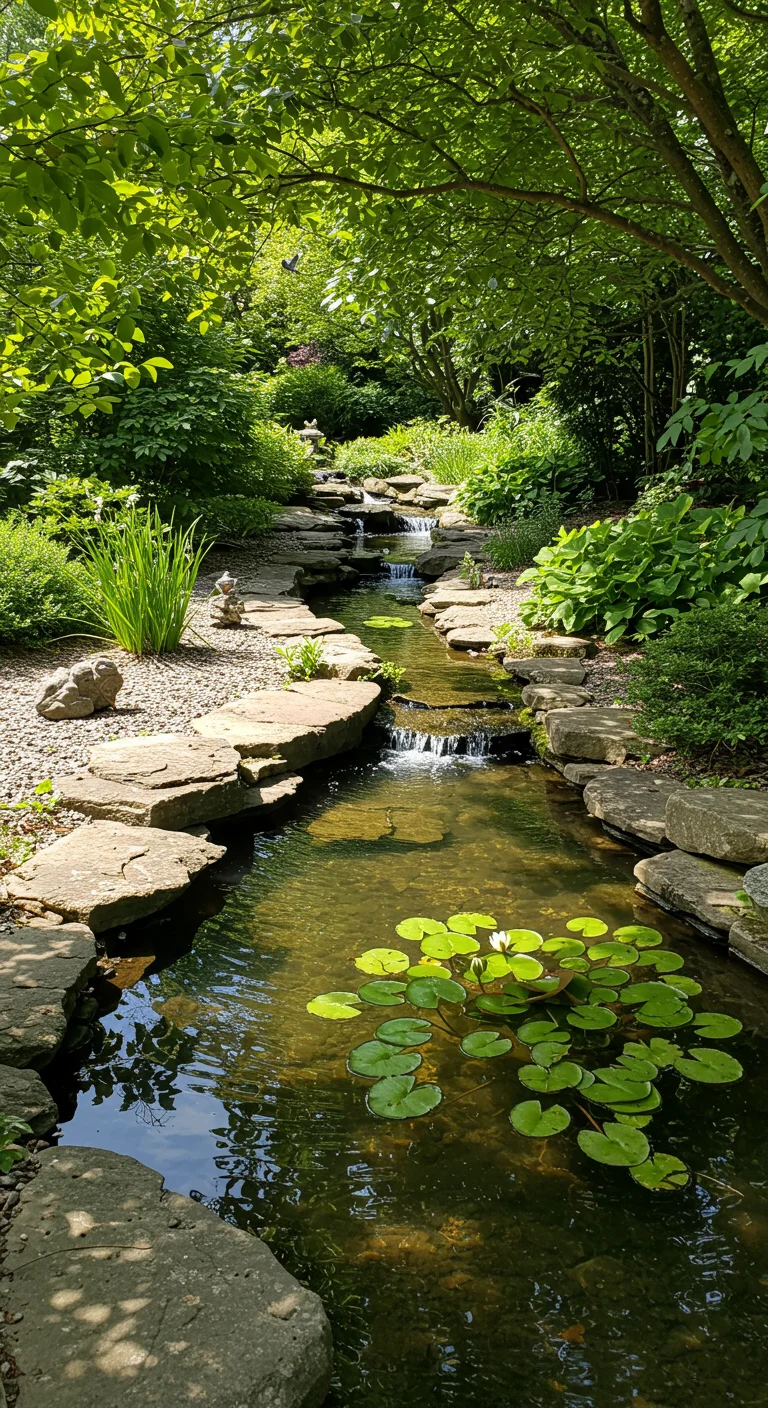
Integrating ponds and streams into your rock garden not only enhances its aesthetic appeal but also introduces a soothing auditory element to the landscape. Begin by selecting a suitable location that receives adequate sunlight yet provides some shade. Use natural stones to create the boundaries of your pond or stream, ensuring they complement the existing rock formations. Incorporate aquatic plants like water lilies or lotus to add vibrant color and texture while also providing habitat for wildlife. A gentle flow of water can be created with a small pump, allowing for a tranquil stream that meanders through your garden. This feature not only attracts birds and beneficial insects but also helps maintain the moisture levels in the surrounding soil, promoting a lush and vibrant ecosystem within your rock garden.
7. Vertical Gardens: Utilizing Walls for Maximum Impact
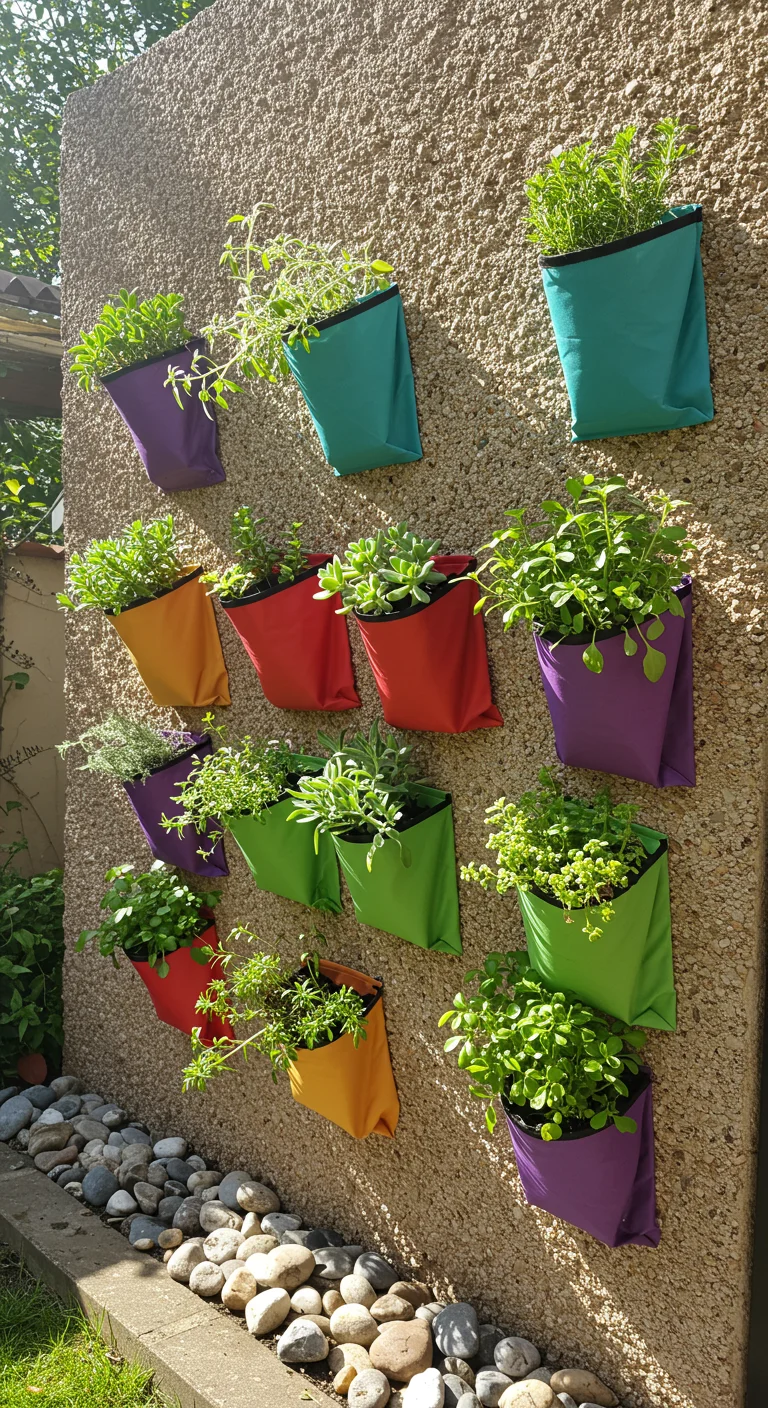
Vertical gardens are an innovative way to maximize your gardening space, especially in rock gardens where ground space is limited. By utilizing walls, fences, or trellises, you can create stunning vertical displays of plants that not only enhance the aesthetics of your garden but also improve air quality and biodiversity. To create a vertical garden, consider using pocket planters filled with drought-resistant plants, such as succulents or herbs, that thrive in rocky environments. Incorporate various heights and textures to add depth and interest, and ensure your chosen plants receive adequate sunlight and watering. This approach not only beautifies walls but also allows you to experiment with design while conserving valuable ground space in your rock garden.
8. Native Natives: Supporting Local Ecosystems
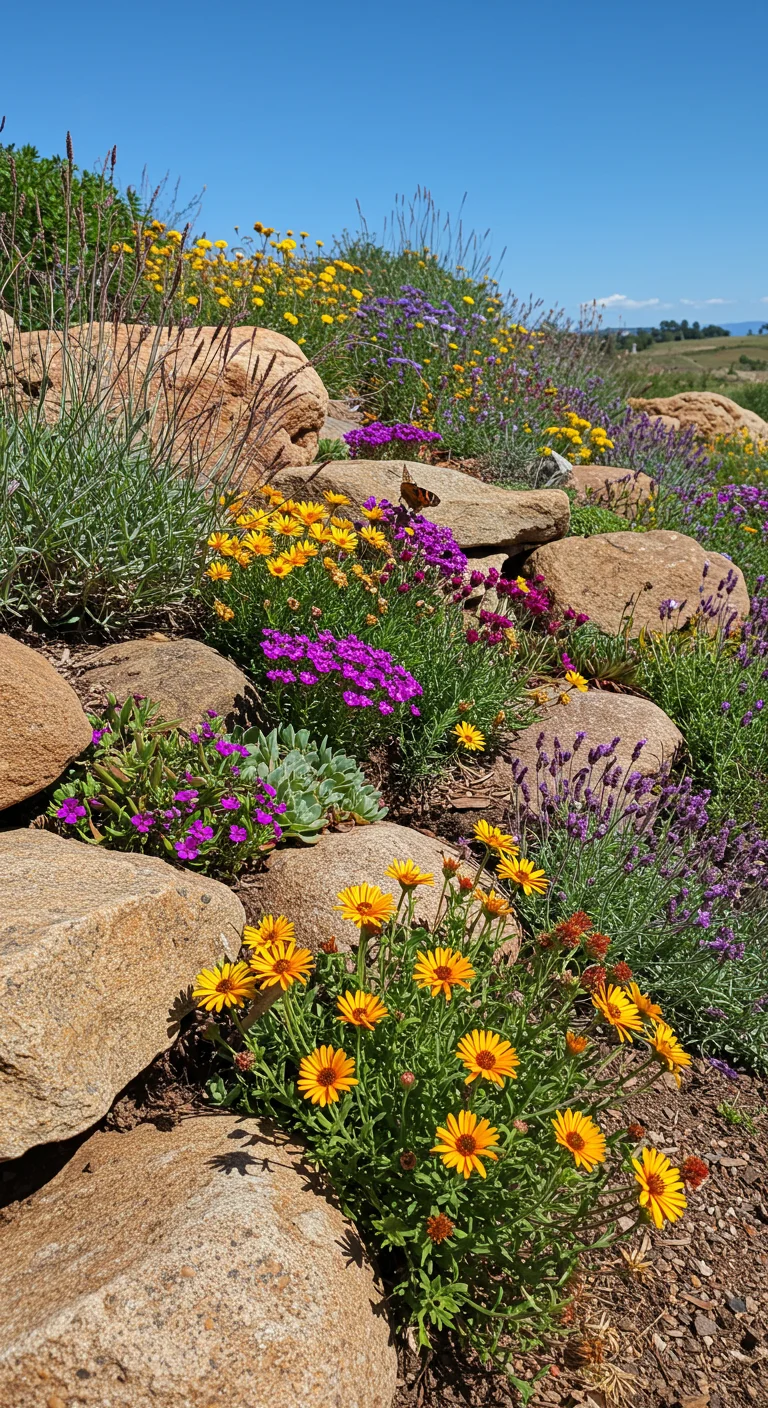
Incorporating native plants into your rock garden is a powerful way to support local ecosystems while enhancing biodiversity. Native species are well-adapted to your local climate, requiring less water and maintenance than non-native varieties. They provide essential habitats and food sources for local wildlife, including birds, bees, and butterflies, fostering a balanced ecosystem. When planning your rock garden, consider using a mix of native grasses, wildflowers, and succulents that thrive in your region. This not only promotes sustainability but also simplifies gardening efforts, as these plants are better equipped to resist local pests and diseases. By choosing native flora, you create a vibrant, thriving landscape that connects your outdoor space to the natural environment around you.
9. Pathways of Purpose: Designing Rock Trails
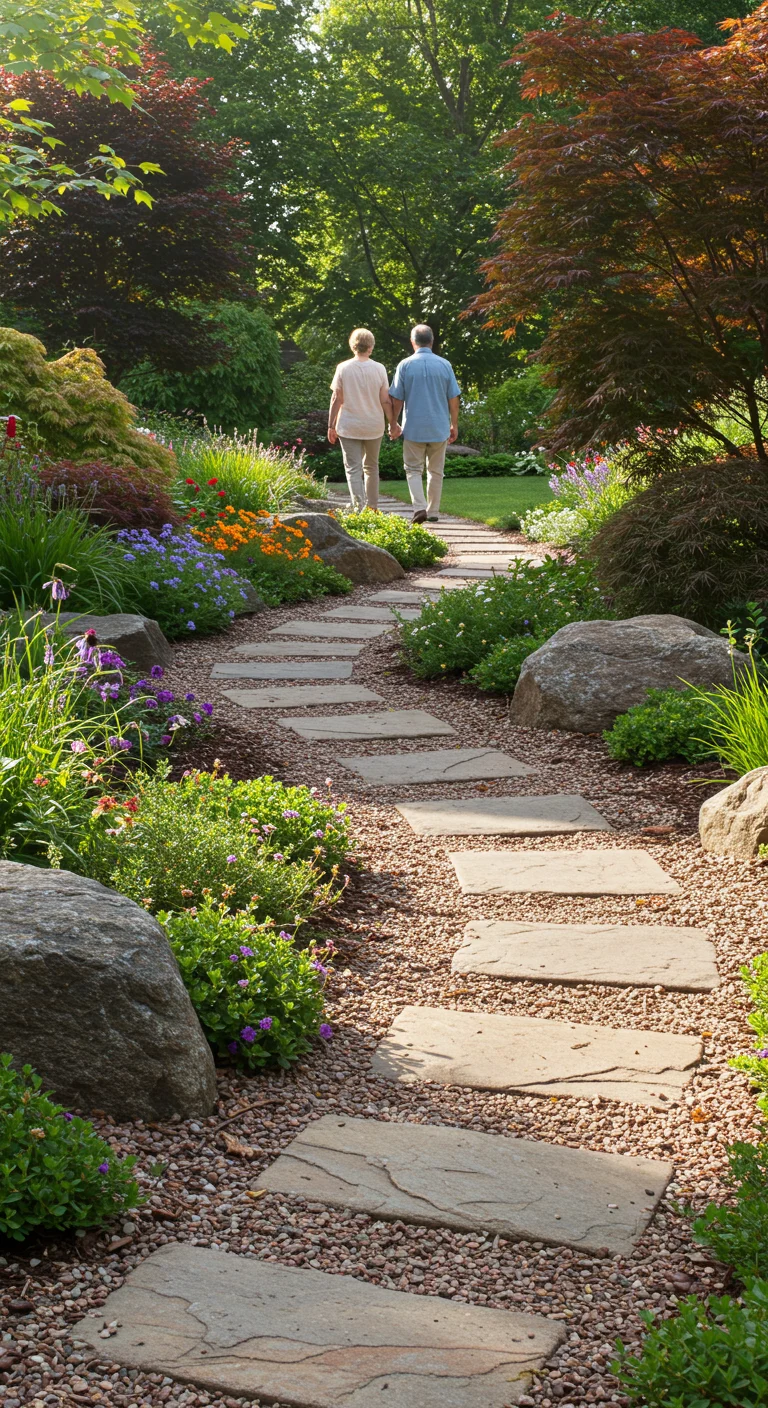
Creating rock trails in your garden not only enhances the aesthetic appeal but also provides practical pathways for exploration and maintenance. To design effective rock trails, begin by selecting flat, smooth stones that are safe to walk on and blend harmoniously with the surrounding flora. Ensure the trail follows a natural flow, avoiding sharp turns and steep inclines for ease of navigation. Incorporate edging stones to define the path, helping to keep mulch or soil contained. Additionally, consider the placement of larger boulders or decorative rocks along the trail to create focal points and encourage wildlife. Make sure the trail is wide enough for two people to walk side by side, promoting a welcoming atmosphere for guests. Finally, plant hardy ground covers along the edges to soften the look and prevent erosion, ensuring your rock trails are both functional and visually appealing.
10. Whimsical Elements: Adding Sculptures and Art
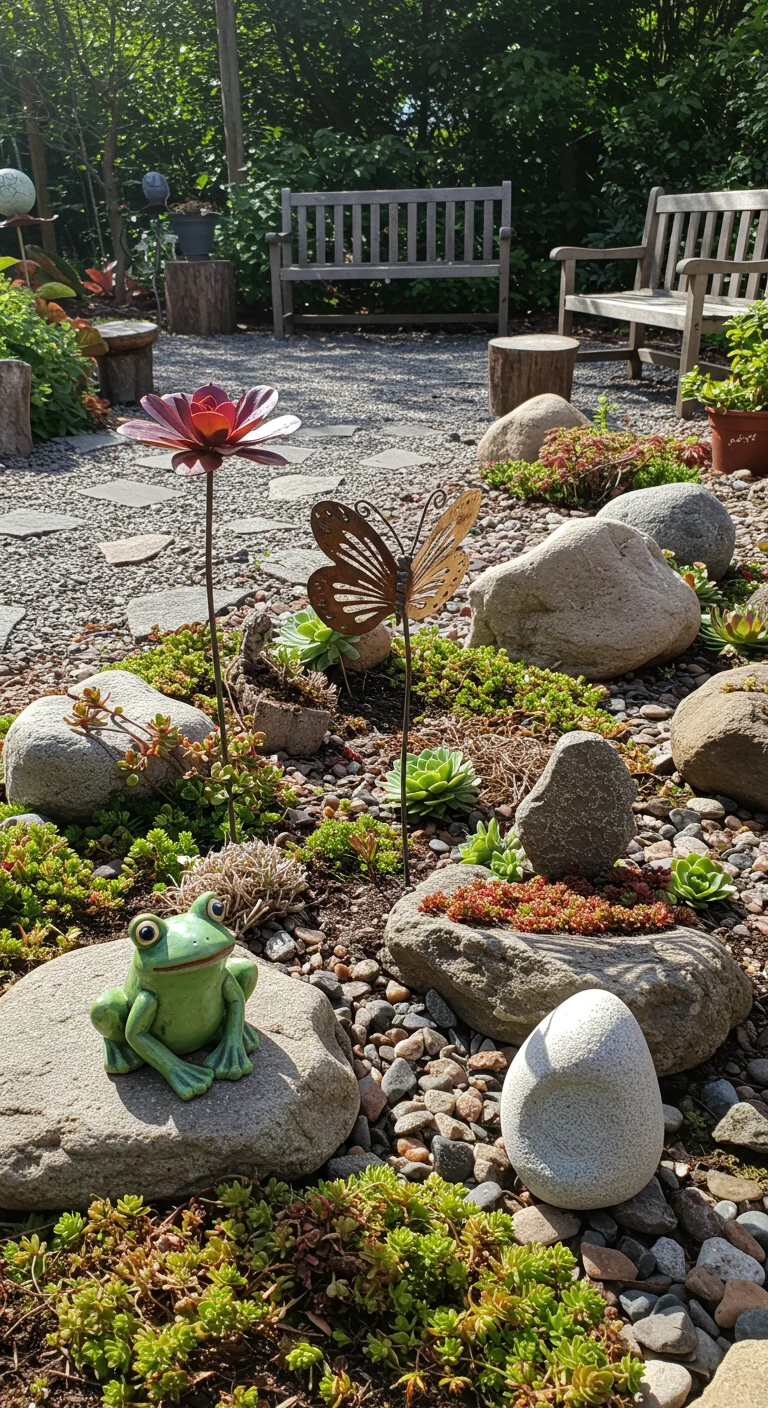
Incorporating whimsical elements such as sculptures and unique art pieces can transform a rock garden from ordinary to extraordinary. Choose sculptures that resonate with your personal style, whether they are playful animal figures, abstract shapes, or elegant statues that complement the natural surroundings. Consider placing these artistic pieces at focal points within the garden, such as near a seating area or amidst clusters of vibrant plants and stones. Additionally, using materials like reclaimed wood, metal, or ceramic can enhance the garden’s texture and visual appeal. Ensure the scale of each sculpture is proportionate to the surrounding elements to maintain harmony, creating a delightful space that invites exploration and admiration.
11. Seasonal Splendor: Planning for Year-Round Interest
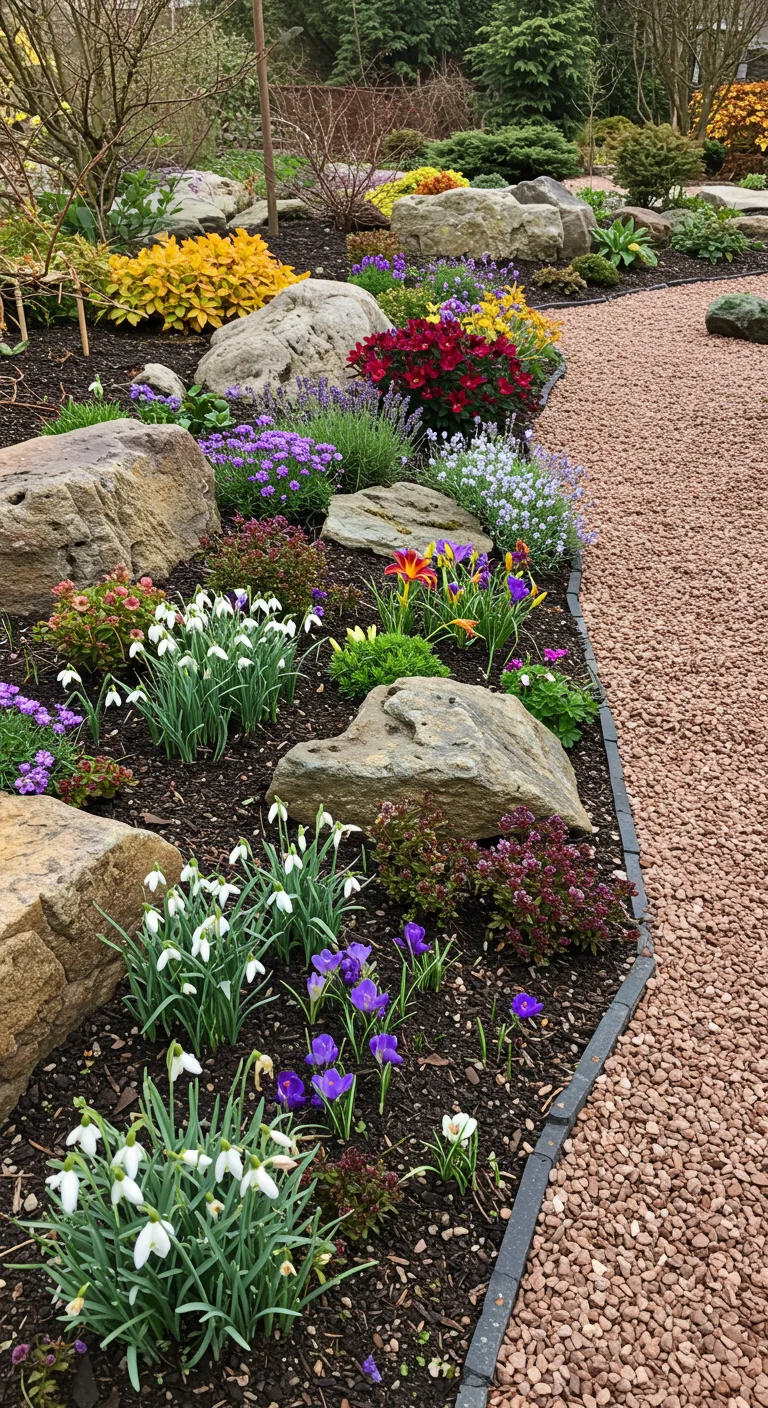
To ensure your rock garden offers seasonal splendor year-round, it’s essential to select a diverse array of plants that bloom at different times throughout the year. Start with early spring perennials like snowdrops and crocuses, followed by vibrant summer flowers such as daylilies and lavender. Incorporate fall favorites like asters and sedums for a colorful autumn display, and finish with winter interest through evergreen plants or ornamental grasses that provide texture and structure. Additionally, consider using rocks and gravel in varying shades to create visual contrast across seasons, and strategically place larger boulders to serve as focal points. This thoughtful planning will create a dynamic landscape that changes beautifully through each season, inviting ongoing enjoyment and admiration from garden enthusiasts and passersby alike.
12. Edible Escapes: Incorporating Herbs and Veggies
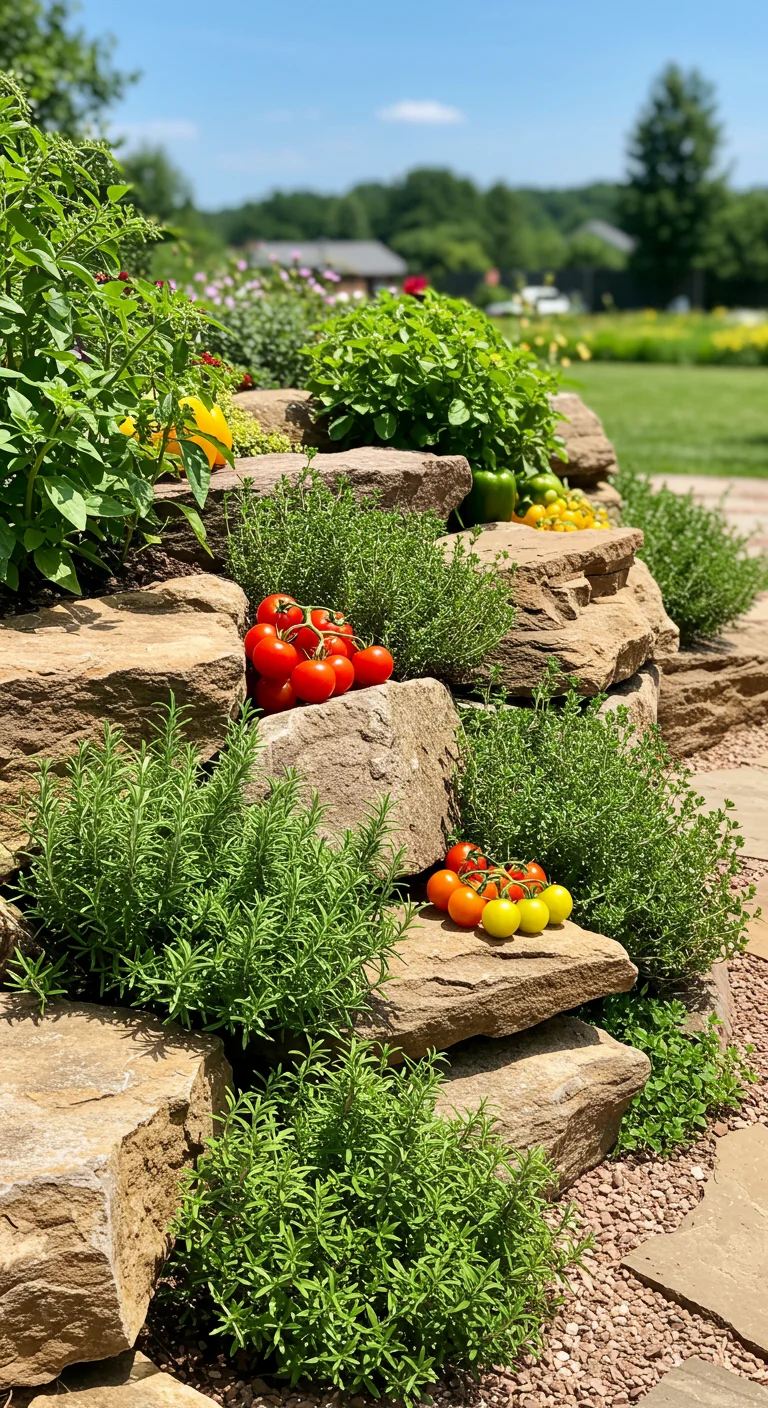
Incorporating herbs and vegetables into your rock garden not only enhances its aesthetic appeal but also offers a functional twist to your gardening efforts. Choose drought-resistant varieties like rosemary, thyme, and sage to add texture and fragrance, while vibrant vegetables such as cherry tomatoes and peppers can provide striking pops of color. Position these plants among the rocks, allowing them to cascade or grow in crevices for a natural look. Utilizing raised beds or stone planters can also help define areas for your edible plants, creating a cozy and inviting atmosphere. Regular care, including proper watering and harvesting, will ensure that your edible escapes thrive, delivering both beauty and fresh produce right from your garden to your table.
13. Fairy Tale Features: Enchanting Tiny Gardens
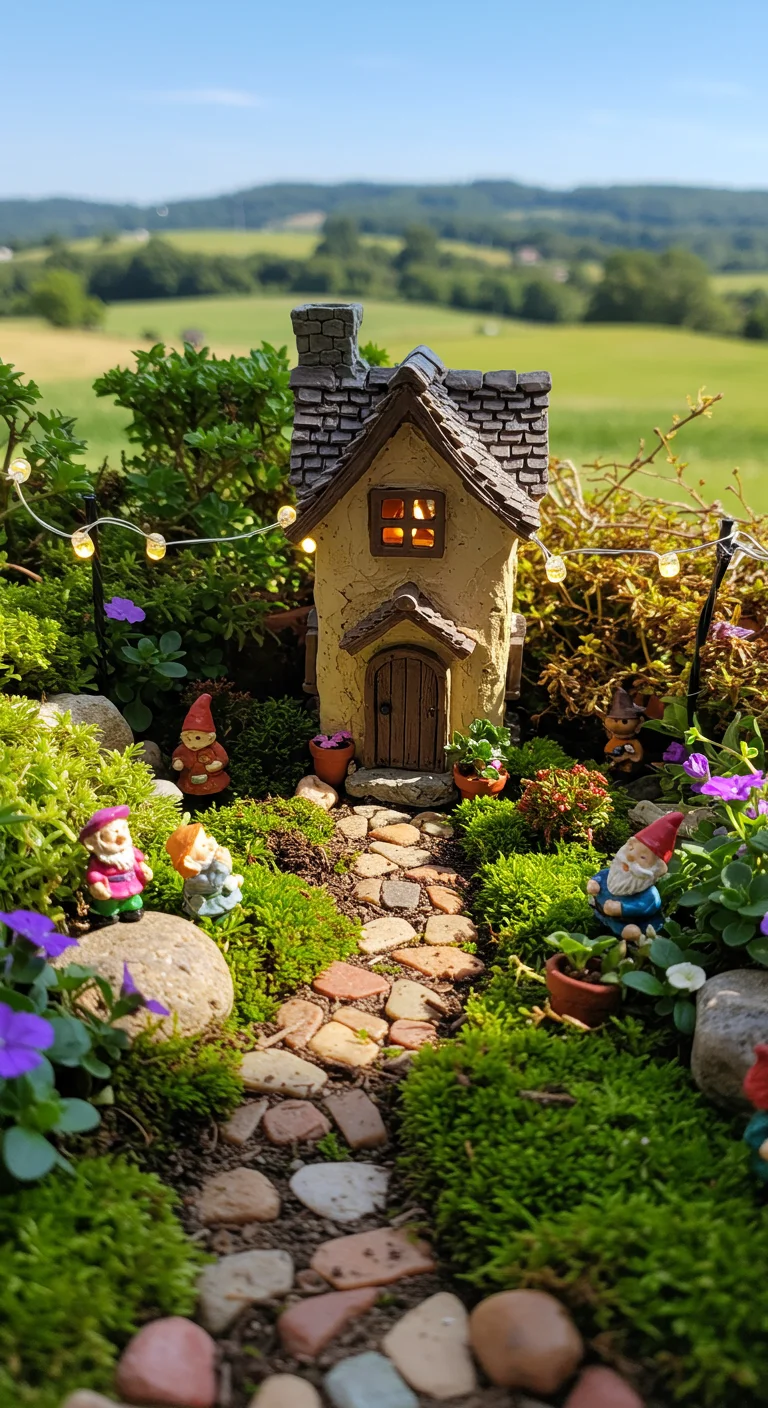
Fairy tale features can transform tiny gardens into enchanting spaces that evoke wonder and charm. Incorporate miniature structures like whimsical cottages or tiny bridges to create a storybook atmosphere. Use decorative elements such as fairy lights, miniature figurines, and colorful garden gnomes to add a magical touch. Layering different types of rocks and plants can create depth and texture; consider using succulents, moss, and small flowering plants for vibrant color against the earthy tones of the stones. Pathways made of pebbles can guide visitors through the garden, while strategically placed seating areas invite relaxation and reflection. By blending natural elements with imaginative decor, your tiny garden can become a delightful escape reminiscent of beloved fairy tales.
14. Fire Pit Focal Points: Cozy Gatherings in Your Garden
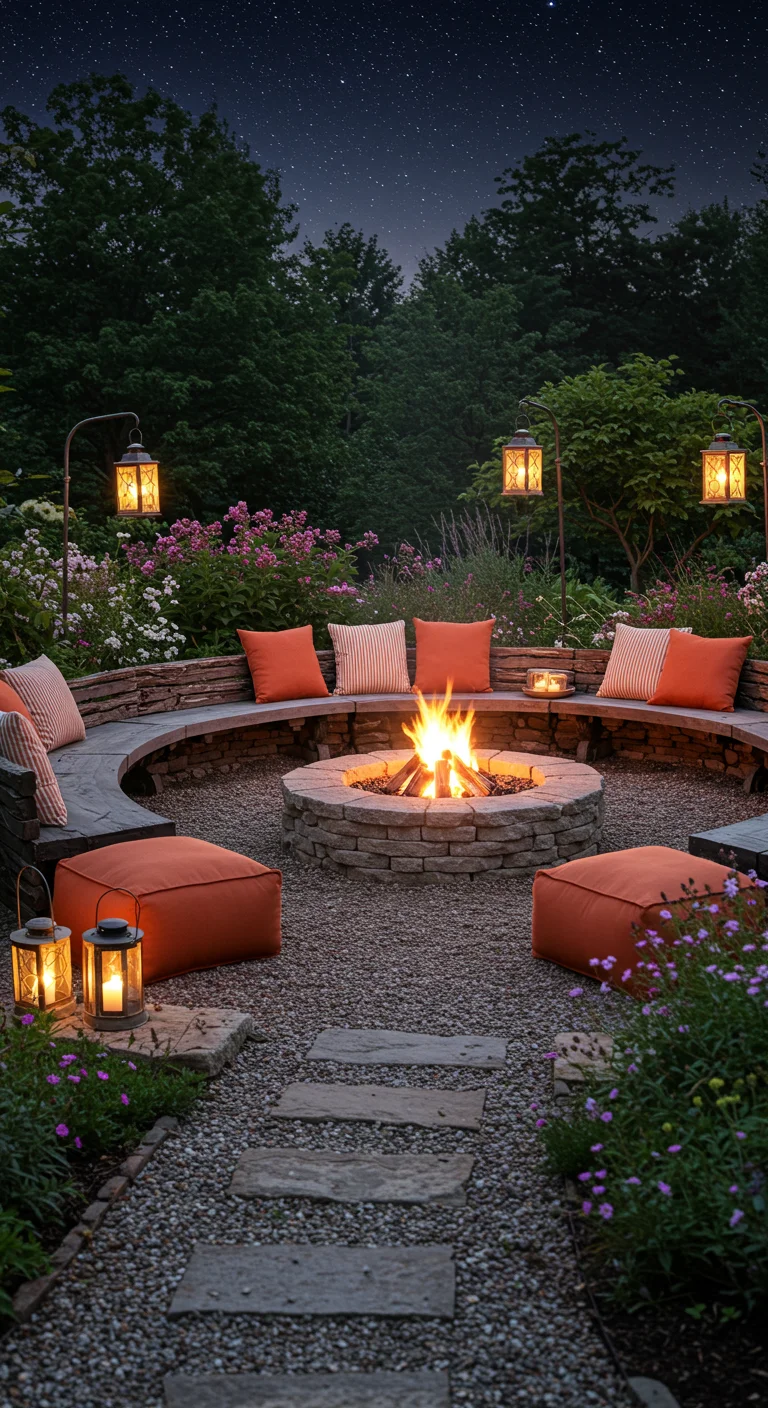
Incorporating a fire pit into your rock garden can transform it into a cozy gathering spot, perfect for evening relaxation and socializing. Consider choosing a circular or square fire pit made from natural stone or fire-resistant materials that harmonize with the surrounding landscape. Surround the fire pit with comfortable seating options like rustic wooden benches or oversized cushions, and incorporate decorative stones or gravel to enhance the aesthetic appeal. To add ambiance, use soft lighting such as lanterns or string lights hanging from nearby trees. This setup not only creates a warm focal point but also encourages family and friends to gather around, making your garden a delightful retreat throughout the year.
15. Minimalist Marvels: The Power of Simplicity
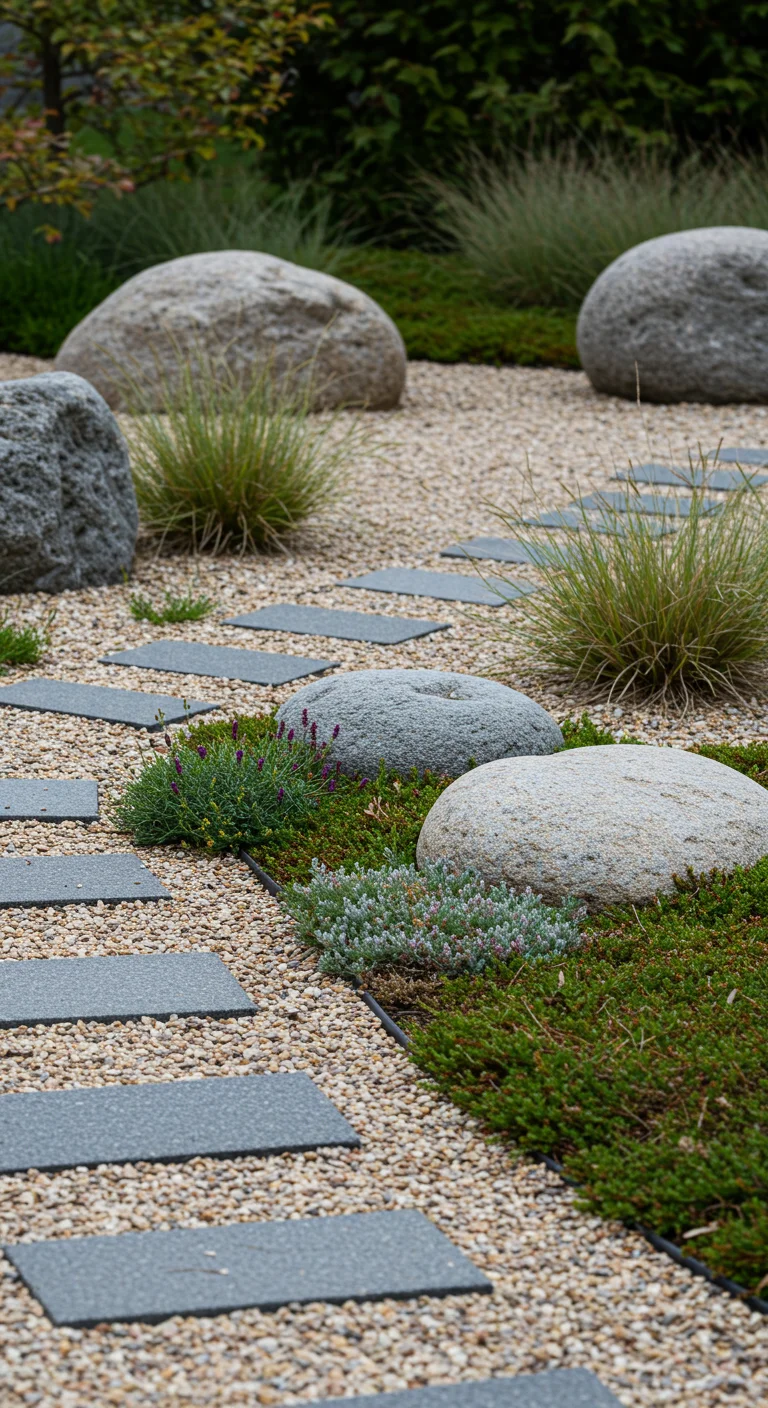
Minimalist rock gardens embrace the beauty of simplicity, allowing nature’s elements to shine without overwhelming distractions. To create a minimalist marvel, start with a limited palette of stones, gravel, and select plants that offer subtle colors and textures. Focus on clean lines and open spaces, ensuring that each component serves a purpose and contributes to the overall harmony of the design. Incorporate native plants that require less maintenance and blend seamlessly with the surrounding landscape. Use boulders and pebbles to define areas and create visual interest while maintaining an uncluttered look. This approach not only saves time and effort in upkeep but also promotes a tranquil environment, making it an ideal retreat for relaxation and reflection.
16. Bold Borders: Defining Spaces with Edging Stones
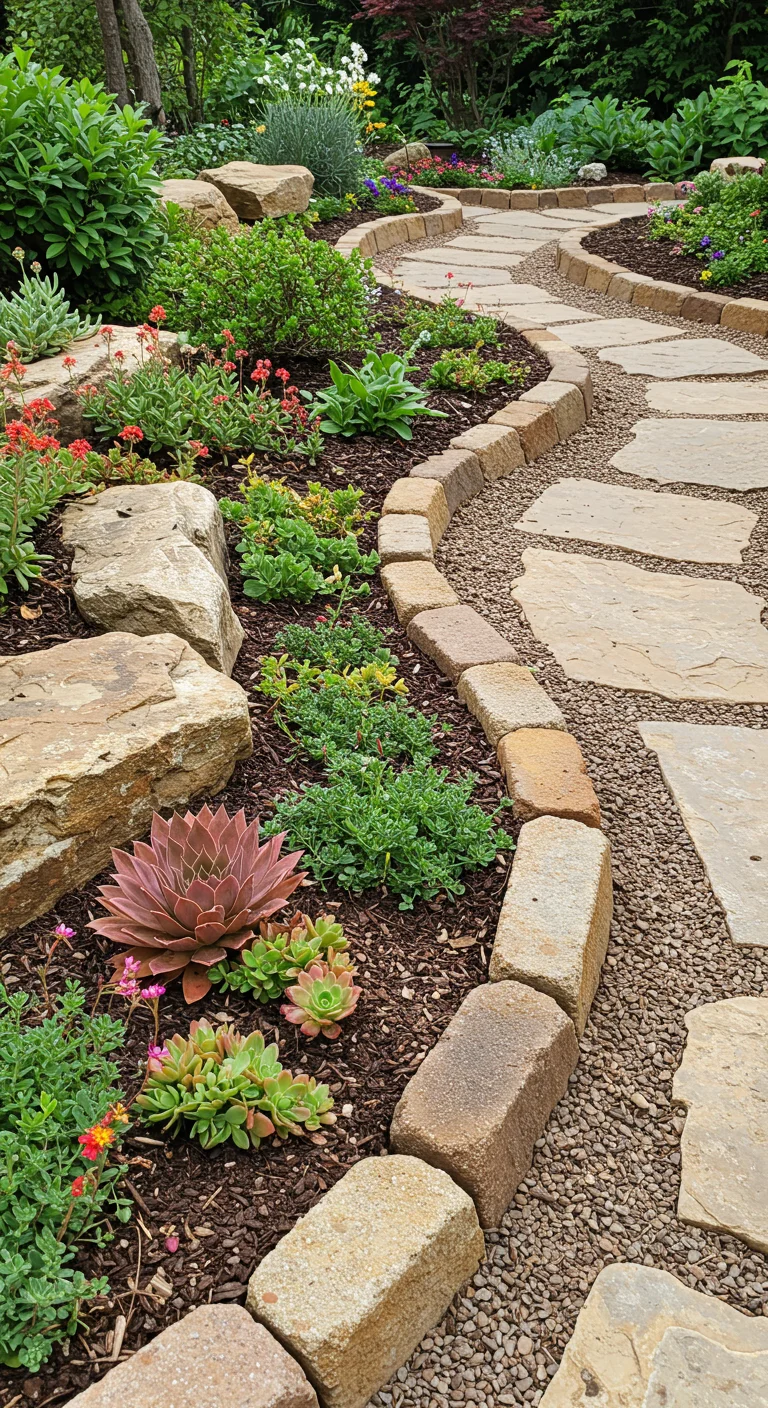
Bold borders using edging stones can significantly enhance the structure and visual appeal of your rock garden. By incorporating a variety of stone types and sizes, you can create defined pathways and borders that guide the eye and provide a sense of organization. Larger, flat stones can be used to line paths, while smaller, rounded stones can create a soft edge around flower beds. Consider using contrasting colors or textures to make the borders pop against the lush greenery of plants and succulents. Additionally, these borders can help with soil retention and weed control, making them both an aesthetic and practical choice for your garden design. Aim for a harmonious balance that complements the natural landscape while clearly defining different areas within your rock garden.
17. Colorful Crassulas: The Magic of Drought-Resistant Plants
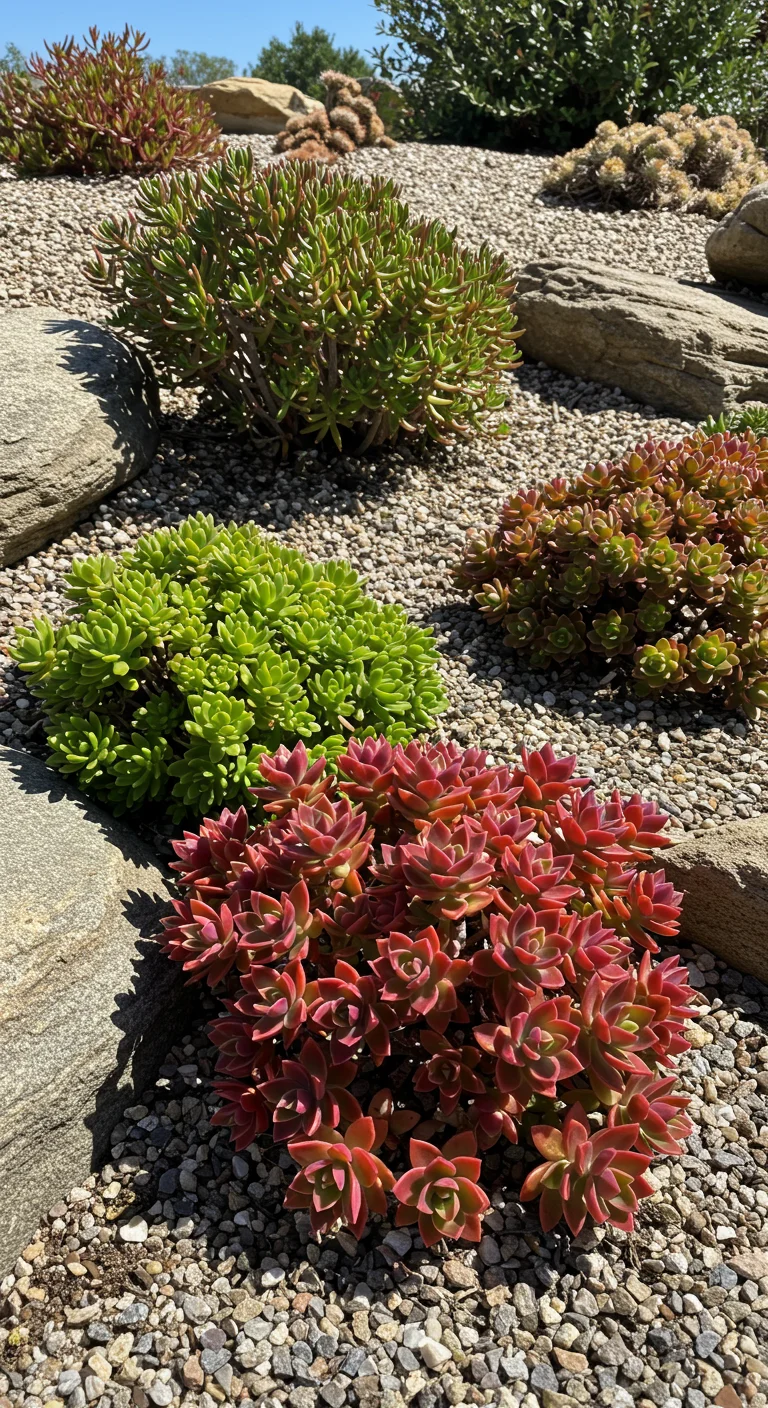
Colorful crassulas are a fantastic choice for rock gardens, bringing vibrant hues and unique textures while requiring minimal care. These drought-resistant succulents thrive in sunny environments and can add a splash of color throughout the year, with varieties showcasing reds, purples, and greens. Crassulas are not only hardy but also versatile; they can be planted in clusters for a dramatic effect or mixed with stones and gravel for an organic look. When designing your rock garden, consider groupings of Crassula ovata (Jade Plant) or Crassula perfoliata for their striking sculptural forms. Ensure well-drained soil and occasional watering to promote healthy growth, making them perfect for low-maintenance landscaping options in arid climates.
18. Texture Triumphs: Mixing Rocks and Plants for Depth
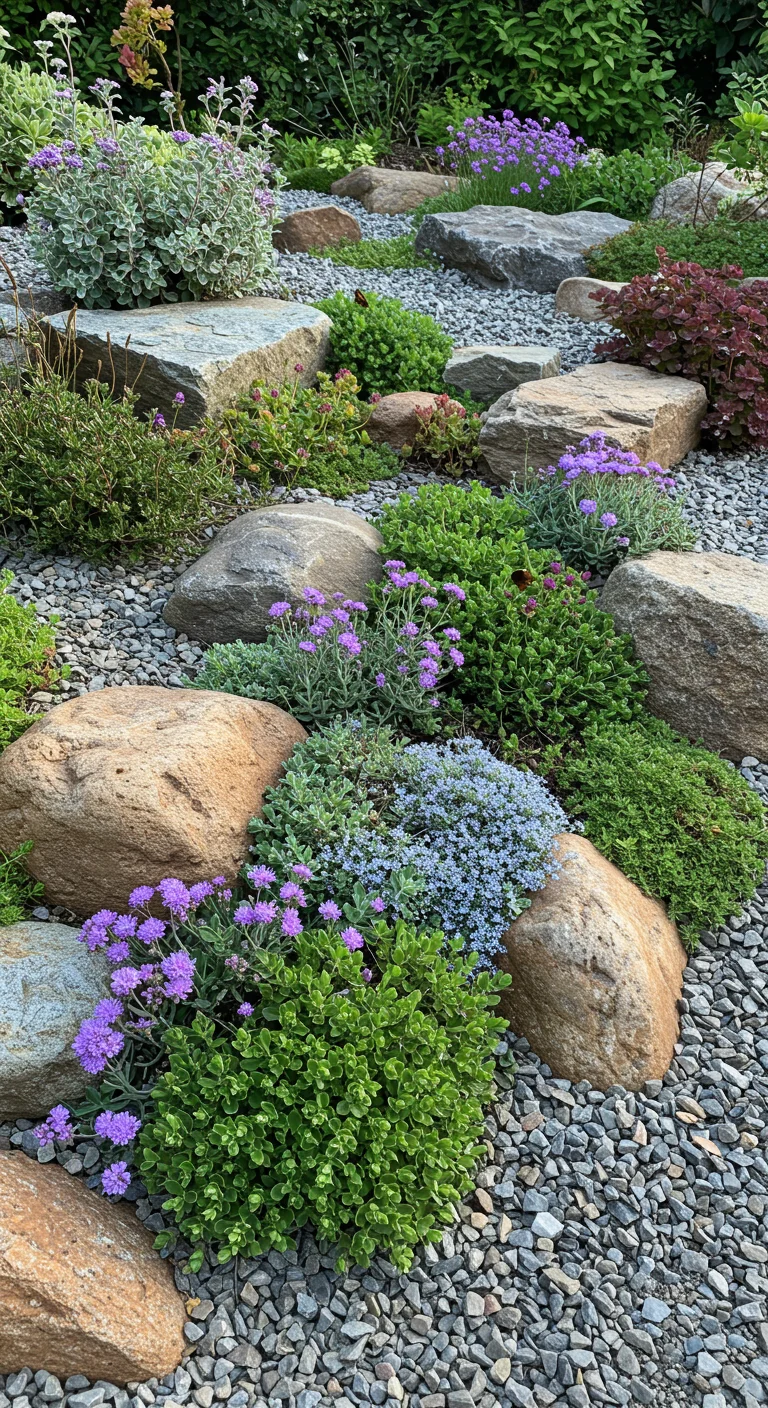
Creating a captivating rock garden requires a thoughtful interplay of rocks and plants to achieve depth and texture. To start, select a variety of rocks in different sizes, shapes, and colors—larger boulders can serve as focal points, while smaller pebbles can fill gaps and create a natural look. When choosing plants, opt for low-growing species such as succulents, alpine plants, and ground covers that can thrive in rocky environments. Arrange plants in clusters around the rocks, ensuring to vary the heights and colors to create visual interest. Consider layering plants, with taller varieties at the back and shorter ones in front, to add dimension. This harmonious mix not only enhances aesthetic appeal but also provides a rich habitat for local wildlife, making your garden a vibrant ecosystem.
19. Nighttime Nooks: Illuminating Your Rock Garden
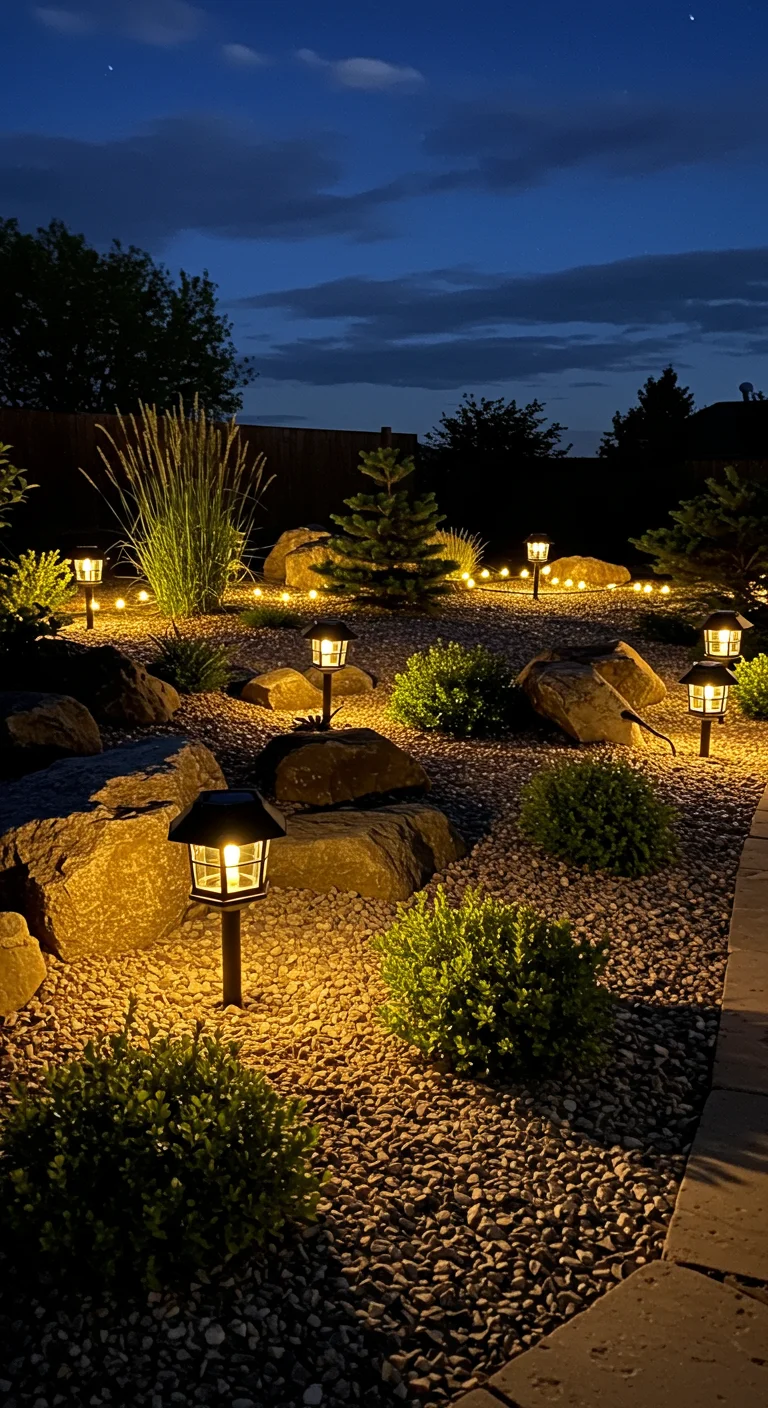
Transform your rock garden into a captivating nighttime oasis by incorporating strategically placed lighting elements that highlight its natural beauty. Consider using solar-powered lanterns and LED string lights to illuminate pathways and key features like unique rock formations or vibrant plant clusters. Position soft, warm lights at ground level to cast gentle glows that create an enchanting atmosphere without overwhelming the serene environment. Don’t forget to include uplighting for taller plants or trees in your garden, which adds depth and drama after dusk. This thoughtful illumination not only enhances the aesthetic appeal but also allows you to enjoy your rock garden long after sunset, making it a perfect retreat for evening relaxation or entertaining guests.
20. DIY Delight: Budget-Friendly Rock Garden Projects
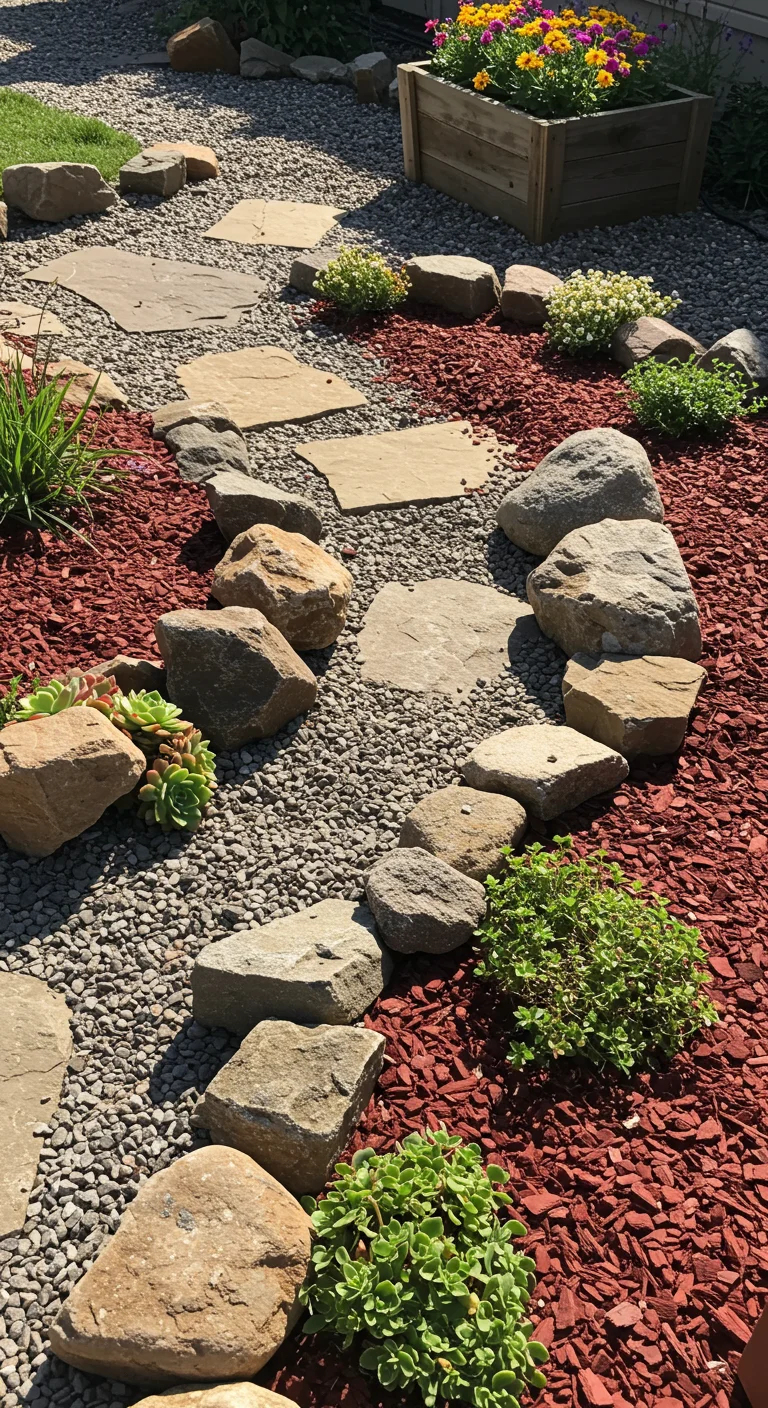
Creating a rock garden on a budget can be both rewarding and enjoyable. Start by sourcing rocks from your local landscape supply or even your backyard; look for interesting shapes and sizes to add character. Use native plants that thrive in your climate, as they typically require less maintenance and are more cost-effective. Consider incorporating gravel or mulch to reduce weeds and retain moisture, while also providing an aesthetically pleasing contrast to the rocks. DIY projects like building a small stone pathway or crafting a rustic planter can add functionality and charm without breaking the bank. Remember to layer your plants by height for visual depth, and don’t hesitate to get creative with repurposed items like broken pottery or wood for added texture, ensuring your rock garden is not only budget-friendly but also uniquely yours.





